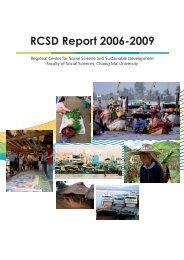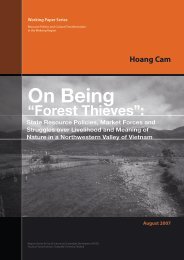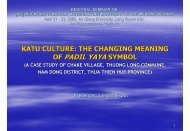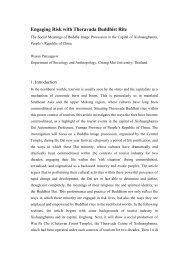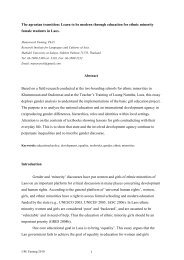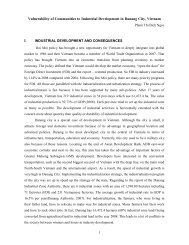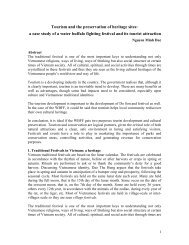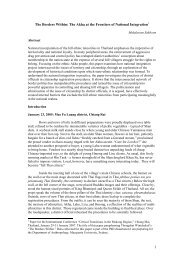Transformation after two decades of agrarian reform ... - RCSD
Transformation after two decades of agrarian reform ... - RCSD
Transformation after two decades of agrarian reform ... - RCSD
You also want an ePaper? Increase the reach of your titles
YUMPU automatically turns print PDFs into web optimized ePapers that Google loves.
which are not particularly accurate; and one that is still defined by traditional patron-clientbonds.Buenavista presents a classic example <strong>of</strong> what seems to be “feudalistic” society, or one that ischaracterized by landlord-tenant/patron-client relationship. Ownership <strong>of</strong> most <strong>of</strong> the lands isconcentrated to only a few families, among them the Reyes and the Uy families (Franco, 2005).During the Marcos regime, the Reyeses in particular, rose to political power and held theleadership <strong>of</strong> the local government unit <strong>of</strong> Buenavista from 1972 until 1986. It was during thistime that they supposedly amassed most <strong>of</strong> the lands in the municipality. After the collapse <strong>of</strong> theMarcos government, they were able to re-establish their power as economic and political elites inthe area by employing the classic “guns, goons, and gold” operandi. To counter these forces, theNew People’s Army (NPA) has also entered the area. Since then, this municipality, just like theBondoc Peninsula in general, has become a hotspot for violent encounters between the armedlandlords, the NPA, and the military. Because <strong>of</strong> the “reign <strong>of</strong> terror” in this municipality,Buenavista is practically cut <strong>of</strong>f from other outside influences.By exercising various forms <strong>of</strong> power play, those in power aim that certain persons, perspectives,issues or conflicts never enter the overt political arena, thereby, maintaining the status quo. Theimplementation <strong>of</strong> the CARP has led many landlords to practice all their means <strong>of</strong> power to resistthe program. Either they overtly refuse to participate in the program or they circumvent the law.Yet, despite this resistance, Buenavista has a strong farmers cooperative and a functioningMunicipal Agrarian Reform Office (MARO). These <strong>two</strong> were instrumental in winning the casebetween a group <strong>of</strong> farmers in one <strong>of</strong> the <strong>agrarian</strong> <strong>reform</strong> sites and the Domingo Reyes estate,owned by the one <strong>of</strong> the most influential and powerful families in Bondoc Peninsula. InDecember 1998, the farmers were granted almost 164 hectares <strong>of</strong> the hacienda (Franco, 2005).As <strong>of</strong> 2006, other pockets <strong>of</strong> <strong>agrarian</strong> <strong>reform</strong> areas have dotted the once consolidatedlandholdings <strong>of</strong> the said family.It is important to note the complexities <strong>of</strong> Buenavista. The “success” <strong>of</strong> the land redistributionprogram in this municipality is said to be attributed to several factors: 1) the presence <strong>of</strong>organized farmers group, in the form <strong>of</strong> a cooperative, that openly fought for its members’8




